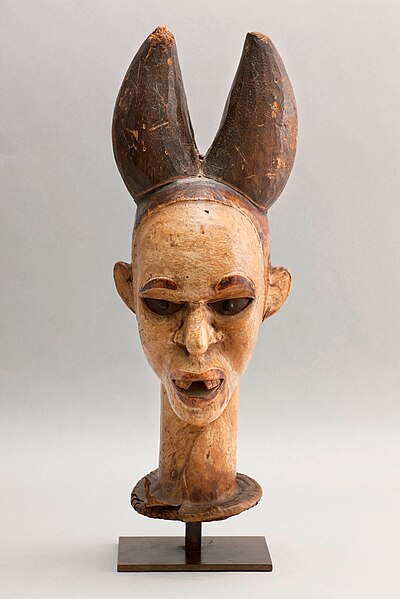Fáìlì:Raccolte Extraeuropee - Passaré 00095 - Maschera cimiero Ejagham - Nigeria.jpg

Ìtóbi ìkọ́yẹ̀wò yìí: 400 × 599 pixels. Àwọn ìgbéhàn míràn: 160 × 240 pixels | 320 × 480 pixels | 513 × 768 pixels | 684 × 1,024 pixels | 1,367 × 2,048 pixels | 4,096 × 6,135 pixels.
Fáìlì àtìbẹ̀rẹ̀ (4,096 × 6,135 pixel, ìtóbi faili: 2.78 MB, irú MIME: image/jpeg)
Ìtàn fáìlì
Ẹ kan kliki lórí ọjọ́ọdún/àkókò kan láti wo fáìlì ọ̀ún bó ṣe hàn ní àkókò na.
| Ọjọ́ọdún/Àkókò | Àwòrán kékeré | Àwọn ìwọ̀n | Oníṣe | Àríwí | |
|---|---|---|---|---|---|
| lọ́wọ́ | 16:35, 14 Oṣù Kẹ̀sán 2012 |  | 4,096 × 6,135 (2.78 MB) | M.casanova | dustspots removed |
| 16:29, 14 Oṣù Kẹ̀sán 2012 |  | 4,096 × 6,135 (2.78 MB) | M.casanova | dustspots removed | |
| 14:34, 27 Oṣù Keje 2012 |  | 4,096 × 6,135 (2.59 MB) | M.casanova | better resolution | |
| 12:53, 6 Oṣù Keje 2012 |  | 534 × 800 (68 KB) | M.casanova |
Ìlò fáìlì
Kò sí ojúewé tó únlo fáìlì yìí.
Ìlò fáìlì káàkiri
Àwọn wiki míràn wọ̀nyí lo fáìlì yìí:
- Ìlò ní arz.wikipedia.org
- Ìlò ní bg.wikipedia.org
- Ìlò ní bn.wikipedia.org
- Ìlò ní crh.wikipedia.org
- Ìlò ní cs.wikipedia.org
- Ìlò ní cv.wikipedia.org
- Ìlò ní de.wikipedia.org
- Ìlò ní en.wikipedia.org
- Ìlò ní fr.wikipedia.org
- Ìlò ní ha.wikipedia.org
- Ìlò ní hu.wikipedia.org
- Ìlò ní hy.wikipedia.org
- Ìlò ní it.wikipedia.org
- Ìlò ní ka.wikipedia.org
- Ìlò ní kk.wikipedia.org
- Ìlò ní ko.wikipedia.org
- Ìlò ní krc.wikipedia.org
- Ìlò ní lbe.wikipedia.org
- Ìlò ní mg.wikipedia.org
- Ìlò ní os.wikipedia.org
- Ìlò ní outreach.wikimedia.org
- Ìlò ní pt.wikipedia.org
- Ìlò ní ru.wikipedia.org
- Ìlò ní ru.wikinews.org
- Ìlò ní sah.wikipedia.org
- Ìlò ní uk.wikipedia.org
Ìfihàn ìlò míràn púpọ̀ fún fálì yìí.


